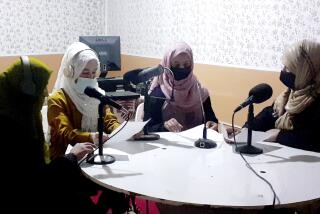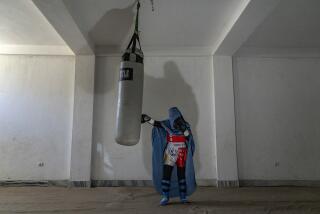A New News Source in Kabul
- Share via
KABUL, Afghanistan — This country’s first international newspaper, Kabul Weekly, put out its inaugural edition Thursday with 10 pages of articles in the local languages Dari and Pashto as well as English and French.
Financed by the U.N. Educational, Scientific and Cultural Organization, or UNESCO, it revived an earlier Kabul Weekly that published from 1993 until 1996, when the government of the time closed it down.
“Second Coming, Year One, Issue Number 1” it said on the front page, over articles in English about this week’s Tokyo donors’ conference, rising opium output, the training of female teachers and the theater in Kabul.
Articles in local languages focused on how Kabul residents view the foreign security forces pouring into the capital and rising crime in the city.
The 10-page weekly actually has two front pages. One, in English, opens from the right. Turn the paper over, and there is another one in Dari, opening from the left, because Afghan languages are written from right to left.
“We want to show the way toward democracy, human rights and women’s rights,” said Editor Fahim Dashty, who was on the staff of the original Kabul Weekly.
UNESCO has put up five months of initial funding for the weekly while the Paris-based press watchdog group Reporters Without Borders has sent computers, printers and other equipment for the six journalists producing the weekly. According to Dashty, 2,500 copies were printed and the first edition was being given away for free.
Dashty was an associate of famed anti-Taliban commander Ahmed Shah Masoud, who was assassinated by two suicide bombers Sept. 9. Dashty was wounded in the blast.
“This is meant to encourage independent media in Afghanistan,” said Eric Davin, head of the French nongovernmental organization AINA, which helped the Kabul Weekly staff get its project off the ground.
Kabul Weekly used to appear only in Dari and Pashto. But now that the Taliban regime has been ousted, the editors expect an influx of foreigners, Dashty said. So they added three pages in English and French to the new edition.
AINA has also set up a media center to help to train Afghan journalists in print, video and photographic journalism.
The table outside the media center offering free copies of Kabul Weekly was a rare sight in the capital, where only two other publications are printed regularly.
More to Read
Sign up for Essential California
The most important California stories and recommendations in your inbox every morning.
You may occasionally receive promotional content from the Los Angeles Times.













